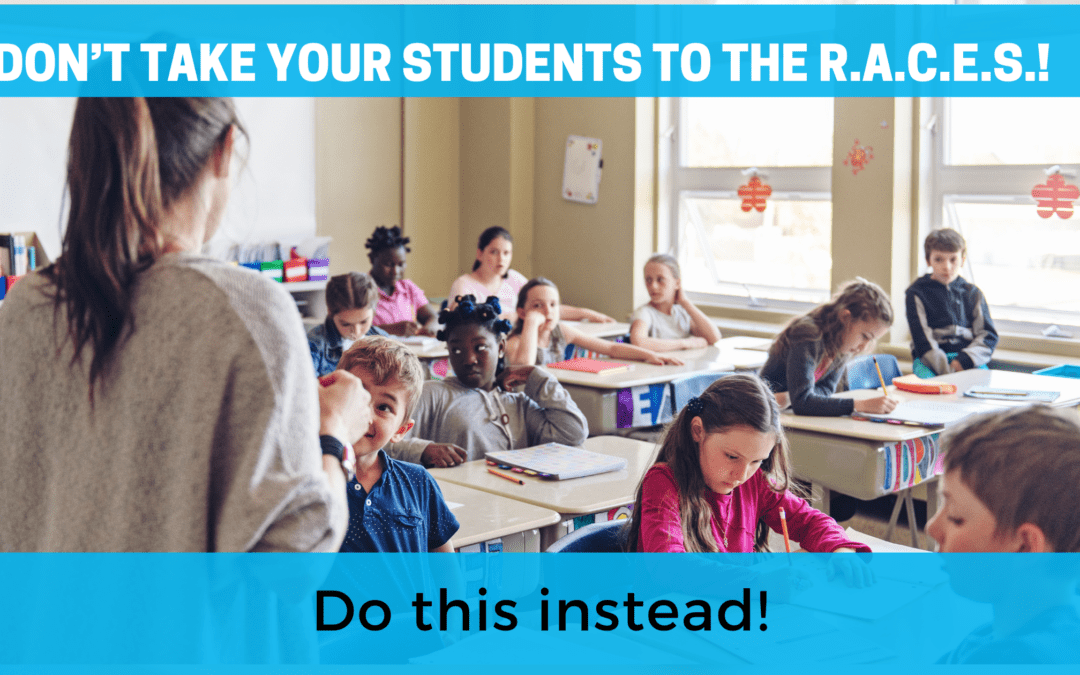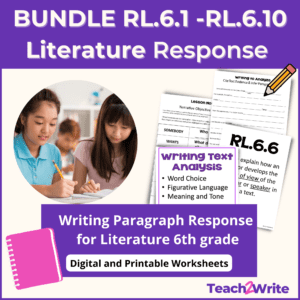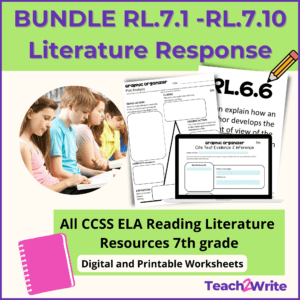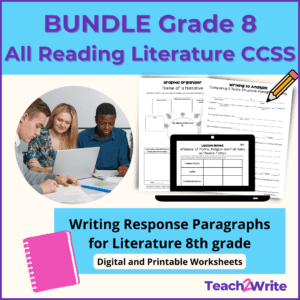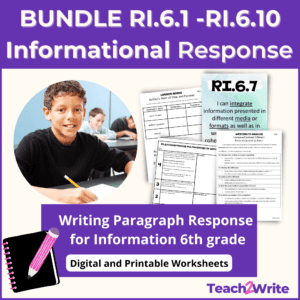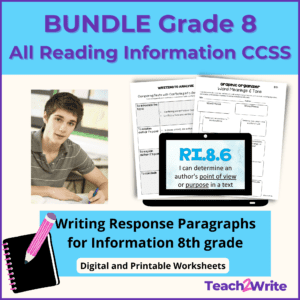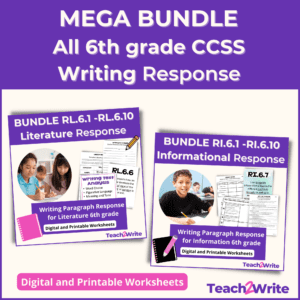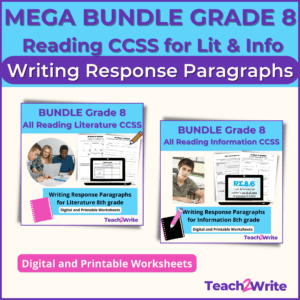Writing Response Paragraphs for Literature
Writing response paragraphs for literature is the solution to a problem I had with my middle school writers. My middle school writers didn’t know how to analyze specifically for questions asked about literature. The rigorous texts brought on by Common Core Reading Literature standards were already difficult enough. So, I desperately searched the Internet for a solution.
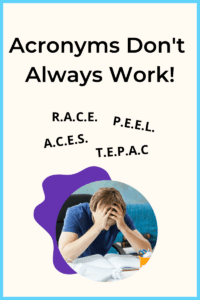
Acronyms Didn’t Work for My Middle School Writers
I tried the RACE strategy, the RACES strategy, ACE, ACES, PEEL, and so many other acronym-based strategies to help them understand how to build a written response paragraph to literature.
I realized that my students may be confused by all the different acronyms taught to them over the elementary school and middle school years!
Not only that, their answers to literary questions went something like this:
In the text, the author says, “do not go gentle into that good night…” in line1. This is important because it is repeated over and over again in the poem. The poet says to his dad not to go gentle into the night.
I needed a way to help my middle school English Language Arts students.
Trying to get my writers to understand that analyzing or explaining a quote by repeating the quote is circular reasoning. It doesn’t tell me anything about why their quote is relevant to their answer. I explained this over and over again – day after day until I wanted to pull my hair out!
Also, the above example paragraph does not mention the author’s name, the title of the text, the genre or the main point about why this quote is important or relevant to the question or prompt.
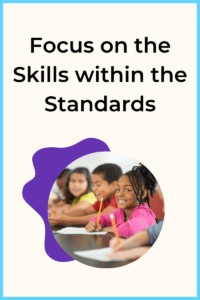
Focusing on the Standard Skills in Writing Response Paragraphs for Literature
In my writing workshop classroom, students floundered when it came to writing response paragraphs for literature.
Additionally, writers didn’t know what part of the text to focus on or what skill we were actually studying. Even though I had it posted, and I spoke about it throughout the lesson! Post-it notes and annotations did nothing to remind them of the skill we were working on. They were just scribbled notes on bright sticky papers they often liked to play with rather than reading!
Next, I tried creating paragraph frames, but they still didn’t connect the skills and key concepts of literature with what they were writing.
That’s when I realized my writers needed a more focused approach to writing response paragraphs. They needed a standards-based approach. So, I set about creating the levels of support I knew my writers required in order to answer these types of questions with any depth of understanding.
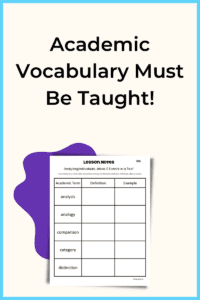
Academic Vocabulary of the Standard
I created vocabulary activities for each standard teaching the academic vocabulary specific to each standard. This was vital to my writers understanding key concepts.
Middle school writers need to know the academic vocabulary for their state testing, and this was a great way to introduce it to students. After this, they needed to use the academic vocabulary words when writing their response paragraphs for literature.
These words would be used throughout the school year and on state tests, so I know these words were essential learning. Also, I would need them to understand the academic vocabulary in order for them to understand rubrics, graphic organizers, paragraph frames and sentence frames – the other supporting activities I created for them.
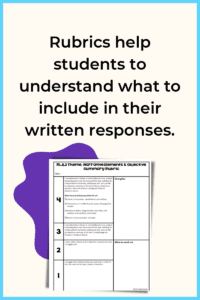
Rubrics for Writing Response Paragraphs for Literature
I needed a way for my writers to understand why they earned certain scores on their writing response paragraphs. Furthermore, I wanted them to know what to include in their paragraphs as well as what they should revise to improve their scores and writing.
By using a 4 point system, I could easily translate the points into grades for progress and quarterly report cards. Plus, I could assess according to which standards my writers mastered and which ones they still needed to improve upon.
Teaching the rubric before teaching the writing, students learned how each standard measured their learning. So, they could monitor their own progress and use the rubric as a checklist. Also, they could write down what they did well and what they could improve.
I gave each student a copy of the rubric to glue into their interactive notebooks for ELA. They could refer to these over and over again, or I could print off a new one each time we worked on that standard.
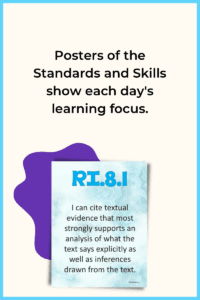
Posters of Standards and Skills
Posting the standards and skills in front of the classroom while we worked on them helped my student writers to remember our learning focus. It also helped visitors from the district office and my assistant principals, who often were responsible for my evaluations, see what our daily focus was.
Needless to say, these posters helped me to achieve highly effective scores for the last six years in a row. This also saved me time from having to write them on the board. Also, if I had them in a presentation, that was often missed by the evaluators who often walk into class after I’d started.
After laminating the posters, I put magnets on the back. It’s very easy to just stick them up in the morning or before I leave for the day.
To stay organized, I keep them in a plastic box next to my whiteboard at the front of the room. I have a piece of construction paper in between the Literature and Information standards, and since they are numbered, I just refile them in numerical order.
These posters were a game changer for me!
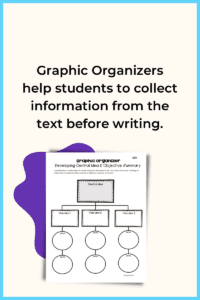
Graphic Organizers for Writing Response Paragraphs for Literature
The graphic organizers that textbook companies and other learning sites publish are too generic for my writers. If I wanted to focus my students on the standards, I needed to create a graphic organizer for each standard. Each organizer focuses specifically on what they need to determine, distinguish, analyze, trace or explain.
With each graphic organizer, I left students space for writing down important information they would need in their paragraphs. Writers needed to be able to write down titles of texts, author’s names, answers to text-dependent questions, text evidence quotes as well as the page numbers for citations.
They also needed a place to explain why that information was important to answering the question. Sometimes, they included a summary. Other times they had to compare. I taught them not to just repeat the author’s words but to explain why they mattered to the topic, character, plot, scene, poem, etc.
However, providing graphic organizers was not enough to support my students who did not know how to start their writing response paragraphs for literature. They needed paragraph frames or sentence stems.
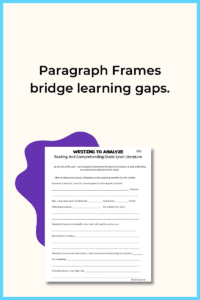
Paragraph Frames Bridge the Learning Gap
For some of my students, especially English Language Learners, students with 504 plans and those with specific learning disabilities, writing is particularly difficult. Especially academic writing.
Although I’d already front-loaded the vocabulary, taught and gave them checklists (rubrics), and graphic organizers, these writers still needed help with how to form all this information into sentences.
Paragraph frames help students to see the order in which everything needs to be stated. Starting with the genre, author and title, then progressing to the answer to the question or main point of the paragraph, they can see where the cited text needs to be written. They can also begin to understand where the analytical part of their answer follows to explain the relevance of their text evidence.
When glued into their notebooks for future reference, these paragraph frames can help them to continue to write new paragraphs about other texts, using the same format.
However, not all students need paragraph frames, and sometimes paragraph frames can be too constricting to writers.
So, I also created sentence stems.
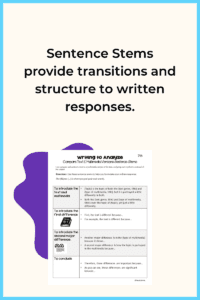
Sentence Stems based on Common Core Standards for Constructed Response
Other students may not need paragraph frames, but they do need the language and transition words to help them to construct a well-written response to literature.
I divided and organized my Sentence Stems into a short list of options for each sentence of a written response. Since each standard requires different information, these sentence stems include the academic vocabulary, transition words and phrasing particular to each skill and standard.
Sentence stems proved to be another game changer because it allowed for more student choice and autonomy as these are suggestions for how to word each sentence, yet still gives students the guidance they need to write their responses.
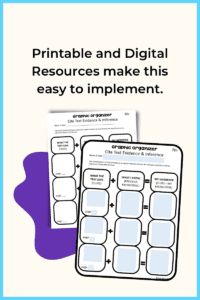
Printable and Digital Resources
Once I made all of these resources for literature, I never had to make any other worksheets. I even made them digital, so I could use them to present with and for students who need to write on a computer. This really came in handy during the last three years of the pandemic!
They can be used in both Google Slides and in PowerPoint. They have text boxes pre-inserted for writers to type into. This makes the digital version extremely easy to use, since I don’t have to go to a copier if my students have computers or a digital device to use.
I continue to use these for my tutoring sessions with my middle school students on Outschool!
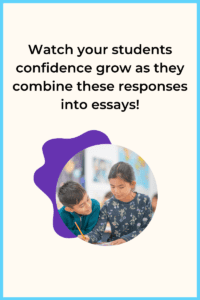
Combining Writing Response Paragraphs for Literature into Academic Literary Essays
Once writers have mastered the standard, I gave them another short piece of text to write paragraphs that led to an essay.
I taught them how to write introductions and conclusion paragraphs, which were easy since the main idea paragraphs were already written.
We practiced these paragraphs all year long with all the different reading literature standards.
Therefore, when yearly testing time came along, my writers were ready to rock the writing portion of their Common Core writing portion of the reading exam.
Here’s a sample of what I created:
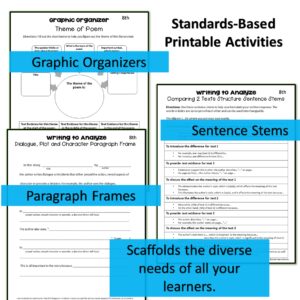
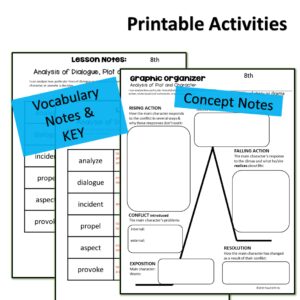

Conclusion: All the work has been done for you in my Writing Response Paragraphs for Literature Resources
All the literature standards for each grade level are listed below. Just click on the image or link to find exactly the standard you need.
These resources all come with a standard poster, skills poster, rubric, graphic organizer(s), vocabulary, some have additional notes, paragraph frames, and sentence stems along with lesson plans for implementation in your classroom.
Like I said, you could also use these in tutoring sessions!
Even better, you can bundle and save – Get all of the reading literature standards writing response paragraph resources at one time. Click on the grade level and type of writing response you need below:
6th grade Literature Writing Response Paragraphs
7th grade Literature Writing Response Paragraphs
8th grade Literature Writing Response Paragraphs
Writing Response Paragraphs for Informational Resources are also available
Click on the grade level you need below:
6th grade Informational Writing Response Paragraphs
7th grade Informational Writing Response Paragraphs
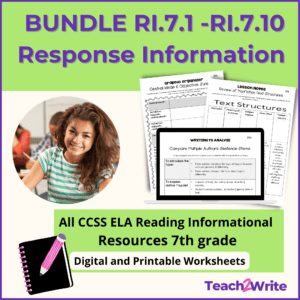
8th grade Informational Writing Response Paragraphs
You can also get both Literature and Informational bundles in a MEGA BUNDLE:
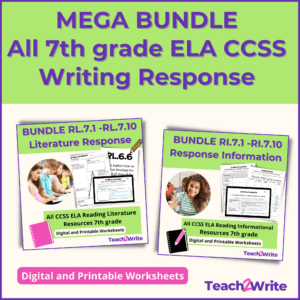
Subscribe to Teach2Write for more information on my new resources as they come available:
If you want to stay up to date with more resources from Teach2Write, sign up for my newsletter here:
You can unsubscribe at any time, and I don’t send out newsletters unless I have something valuable to share.

